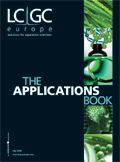Quantitative LC–MS Analysis of Perfluorochemicals
The Application Notebook
This application note describes a fast and sensitive LC–MS method using a Hypersil GOLD column on a Thermo Scientific LC–MS system for the quantitative analysis of two widespread PFCs, perfluorooctanoic acid (PFOA) and perfluorooctansulphonate (PFOS).
Günter Böhm, Thermo Fisher Scientific Inc., Runcorn, Cheshire, UK.
This application note describes a fast and sensitive LC–MS method using a Hypersil GOLD column on a Thermo Scientific LC–MS system for the quantitative analysis of two widespread PFCs, perfluorooctanoic acid (PFOA) and perfluorooctansulphonate (PFOS).
Perfluorochemicals (PFCs) are used in the manufacture of many industrial products such as surfactants, polymers and plastic additives. Monitoring their environmental accumulation is of importance because of their widespread use and high chemical stability. Of special concern is the accumulation in various biological species, including man. Although the toxicological effects are not well understood it is clear that PFCs may impact on the peroxisome proliferation, membrane function and the reproductive system. It is, therefore, essential to have sensitive methods in place to allow detection and quantification of traces of PFCs. The Hypersil GOLD column, based on ultra-pure silica and state-of-the-art bonding, generates highly efficient and symmetrical peaks allowing for good peak height and signal-to-noise ratios for the PFCs.

Figure 1
Experimental Conditions
LC/ESI/MS
LC system: Thermo Scientific Rheos 2000 pump
Column: Hypersil GOLD 3 µm, 50 × 2.1 mm
Part number: 25003-052130
Mobile phase: A: 2 mM NH4Ac in water/methanol (95:5) B: 2 mM NH4Ac in methanol
Gradient: Time (min) %B
0.0 55
3.0 85
3.1 95
4.0 55
5.0 55
Flow-rate: 0.3 mL/min
Injection volume: 10 µL
MS system: Thermo Scientific MSQ Plus
Detection: Negative ESI (400 °C, 90 eV)
Scan range: 0–2.45 min SIM m/z 368.9; 2.46–4.0 min SIM m/z 498.8
Selected ions:m/z 368.9 (fragment of PFOA m/z 412.8→368.9) m/z 498.8 (PFOS)
Dwell time: 0.6 s
Std solutions: Stock solutions of PFOA and PFOS at a concentration of 500 µg/mL.
Dilutions: Ten-fold serial dilutions into water/methanol (50:50): 50 µg/mL, 5 µg/mL, 0.5 µg/mL, 0.05 µg/mL, 0.005 µg/mL and 0.0005 µg/mL
Results and Discussion
Limits of quantification of 0.25 ng/mL for PFOA and of 0.08 ng/mL for PFOS were obtained (%RSD 3.8%, n = 5 for PFOA and RSD 1.4%, n = 5 for PFOS). Low delay volume pumps (Rheos 2000/Thermo Scientific Accela) enable fast gradient delivery and run times of 5 min per sample. The acquisition of PFOA is performed using a fragment ion (generated by SID-source induced dissociation) of PFOA, therefore, increasing the sensitivity of the method. This method allows a fast, high throughput and sensitive assay for the quantification of two important and widespread perfluorochemicals.
References
1. A. Kärmann et al., Anal. Chem., 77, 864–870 (2005) and literature cited therein.

Thermo Fisher Scientific Inc.
112 Chadwick Road, Runcorn, Cheshire WA7 1 PR, UK
tel. +44 1928 581000
Website: www.thermo.com/columns

Study Explores Thin-Film Extraction of Biogenic Amines via HPLC-MS/MS
March 27th 2025Scientists from Tabriz University and the University of Tabriz explored cellulose acetate-UiO-66-COOH as an affordable coating sorbent for thin film extraction of biogenic amines from cheese and alcohol-free beverages using HPLC-MS/MS.
Multi-Step Preparative LC–MS Workflow for Peptide Purification
March 21st 2025This article introduces a multi-step preparative purification workflow for synthetic peptides using liquid chromatography–mass spectrometry (LC–MS). The process involves optimizing separation conditions, scaling-up, fractionating, and confirming purity and recovery, using a single LC–MS system. High purity and recovery rates for synthetic peptides such as parathormone (PTH) are achieved. The method allows efficient purification and accurate confirmation of peptide synthesis and is suitable for handling complex preparative purification tasks.















